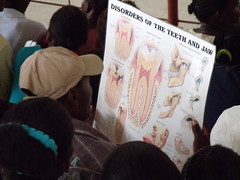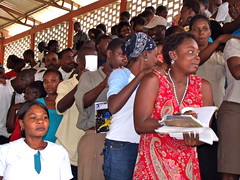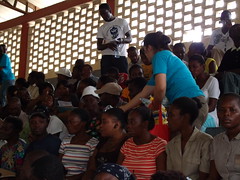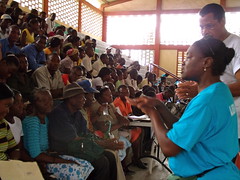2011 HAITI SUMMER SERVICE PROJECT REPORT
This year's project was our fourth annual service project in Haiti, the second one since the 2010 earthquake. Our focus to help those suffering from diverse health situations and poverty became more vital and intense following the outflow of earthquake victims who came to Cap-Haitien, the second-largest city in Haiti (where we have concentrated our most recent efforts). Cap-Haitien was already straining to care for its citizens. Last year, based on the people's request, we promised Cap-Haitien Mayor Fritz Joseph we would return this year and provide a Health Education Seminar and a mobile medical clinic with ALHMEDA, the volunteer doctor team we have worked with since we began our projects in Haiti.
ARRIVAL IN CAP-HAITIEN
This year, I was joined by 11 outstanding volunteers from across the United States. Beatrice Abbott, a registered nurse at the Veterans Administration in Tampa; her husband Earl, a registered nurse as well; and their daughter Joelle, a student at the University of South Florida, all did a fantastic job of supporting the project and gave excellent presentations. Lydia Martin, a friend of the Abbotts', another RN, brought her deep knowledge of dental hygiene. Gudrun Gavin, an RN and Minnesota Universal Peace Federation leader, brought with her a most needed character education program. Margaret Brewster, an RN and chairwoman of WFWP in Boston brought her expertise in homeopathic medicine. Julia DePauw, an RN, an expert in midwifery, and WFWP assistant chairwoman in Jacksonville, Fla., shared her great knowledge. Manasa Kanithi, a student at the University of South Florida and president of WFWP at USF, was very enthusiastic, as this was her second year in a row to go. Huong Phan, another USF student, is studying dentistry and is an officer with WFWP helping Manasa. There were also Robin Baldwin, an education student at USF and a member of WFWP, and Kathleen Heitzinger, a high school student from New Mexico. Both Robin and Kathleen were a joy to have on the trip.
We all traveled to and met at the Fort Lauderdale International Airport before boarding a plane for Santiago, Dominican Republic. From Santiago, we traveled to the Haiti border, where Mayor Joseph's brother met us and drove us to our quarters in Cap-Haitien. We were blessed to have a large rented guesthouse waiting for us. Our supporter, Mark Spowage, had rented a 4000-square-foot house for a year with six bedrooms and three stories overlooking the city. This house was located by three precious supporters in Haiti: Douyon Dameus, Gardy Charles, and Dimache Jackson. These brothers worked with us the entire week.
Upon arriving at the guesthouse, we were met by the brothers and Mayor Joseph, who was there waiting for us. We had a good planning session over dinner and we introduced ourselves to the mayor. Afterward, we prepared the medications we had brought in our suitcases and retired for the night.
DAY ONE: SIGHTSEEING AT THE CITADEL AND THE SANS-SOUCI PALACE
We spent our first day in Haiti viewing one of the world's most wondrous sites, the Citadel. The Citadel Laferrière is a large mountaintop fortress in northern Haiti, approximately 17 miles south of the city of Cap-Haitien and five miles uphill from the town of Milot. It is the largest fortress in the Americas and was designated by UNESCO as a World Heritage Site in 1982—along with the nearby Sans-Souci Palace. The mountaintop fortress has itself become an icon of Haiti. The Citadel was built by Henri Christophe, a key leader during the Haitian slave rebellion, after Haiti gained independence from France at the beginning of the 19th century. It takes two hours to walk the road leading up to the Citadel. It was a long climb, but everyone enjoyed themselves and took many pictures. We also enjoyed the Sans-Souci Palace. Some of us attended the church King Christophe used to go to. While sitting in the park, we met three wonderful Catholic nuns with whom we talked deeply and who are quite interested in WFWP and our character education program.
We arrived back at the guesthouse that evening. After a good meal, we met to go over the plans for the seminar.
DAY TWO: HEALTH EDUCATION SEMINAR, PART 1
We began our second day by traveling to a local gymnasium prepared by the Mayor Joseph. Once there we waited for the arrival of civic leaders, women's organization leaders, and an association of midwife leaders from all over the north of Haiti. Mrs. Abbott, who is originally from Haiti and who retired from the U.S. Air Force, led off the seminar with presentations on hypertension, diabetes, infectious diseases, and malnutrition. She was caring and sensitive to the participants, reminding them of the need to simply wash their hands to prevent the spread of germs. She gave great guidance on the above topics, indicating that a change of diet is essential, from carbohydrates to fruits and vegetables and more. Next, Earl Abbott spoke on first aid, CPR, and the Heimlech Maneuver. One older gentleman was so moved by this. He related a story of how, in the past, persons who had gone into cardiac arrest were brought to the morgue only to later revive. The people, having seen this, saw this person as a zombie and beat this person to death with sticks. This reminded me of the biblical verse, "My people perish for the lack of knowledge."
After Mr. Abbott spoke, Julia DePauw gave a wonderful presentation on midwifery. The midwives in the audience, some of whom had practiced for 40-50 years, were impressed. Mrs. DePauw covered all aspects of midwifery, including prenatal care, essentials of birth, assisting with birth, complications, and post-partum care. She brought charts and explained what to do in an emergency, for example, when the child is in a breech position. She said it's best to bring the mother to the hospital, as a Caesarean section may be necessary. She also showed how to turn the baby in the womb in case the mother couldn't get to the hospital. Mrs. DePauw did a great job and Dr. Monique Jean, one of the ALHMEDA volunteer doctors, helped by answering some of the more technical questions.
DAY THREE: HEALTH EDUCATION SEMINAR, PART 2
Our second day of the health seminar began with Mrs. DePauw continuing her session on midwifery on the side with a group of midwives, who had questions. At the same, Lydia Martin, assisted by Huong Phan, gave a presentation on dental hygiene to the rest of the participants. Mrs. Martin talked about basic dental care, such as proper brushing techniques to avoid cavities, brushing of the gums to prevent gum disease, and brushing of the tongue to eliminate bacteria that could cause not only bad breath but tooth decay. She brought many charts to show and closed her session by handing out toothbrushes and toothpaste.
After this, Margaret Brewster, spoke on homeopathic first aid. She went into foot reflexology, handing out a chart that showed all the systems of the body that can be affected positively by properly massaging the feet. She covered the whole anatomy--skeletal system, muscular system, nervous system, lymphatic system, and more. She showed how the heart and lungs could be helped, the liver, reproductive system--all aspects of one's health. The audience was amazed and excited about using this technique at home to heal themselves. Mrs. Brewster concluded her presentation by handing out 40 samples of homeopathic medicine (remedies based on plants) to each woman leader present.
Altogether, 250 persons participated during the two-day seminar. Each received a beautiful certificate, printed with his or her name and signed by Angelika Selle, president of WFWP USA; Mayor Fritz Joseph; Mrs. Brewster; Miss Kanithi; and myself.
DAY FOUR: MOBILE MEDICAL CLINIC, PART 1
On day four, we traveled to Nan Banaan. Nan Banaan is a very impoverished area within the city of Cap-Haitien. The people came to us with many kinds of ailments. 150 families and individuals were already there to be seen. Our team of nurses worked seamlessly with the doctors from ALHMEDA. Dr. Monique Jean, of ALHMEDA, saw 63 people by herself, working five hours with no break until the other doctors arrived. Then Dr. Jean Marie Colin and Dr. Wilgan Mompremier took over and saw another 87 people, working until 6 p.m. While the doctors gave consultations and prescribed medicines, Mr. Abbott, Gudrun Gavin, and I handled the pharmacy. At the same time, Mrs. Martin took the patients' blood pressure. Manasa, Joelle, and Kathleen, together with Dimache and Gardy, registered the patients and helped with the pharmacy before departing to visit a small elementary school, where they handed out toys to the kids.
The 150 patients were very moved by the doctors and nurses and by the care they gave.
DAY FIVE: MOBILE MEDICAL CLINIC, PART 2
This day, we went to Conasa, another part of Cap-Haitien. We were welcomed by the delegate, a man responsible for that area. Life in Conasa is difficult for adults and children alike. They lack the basic necessities of life: clean drinking water, sanitation, food, and shelter. Again the doctors saw about 150 patients, many of whom were anemic, or suffering from malnutrition and worms. Mrs. DePauw, Mrs. Martin, and Mrs. Abbott took blood pressure, while I translated for the patients to receive their proper medication. At one point, we had to go out and buy more vitamins and medicine. I want to state how gratetful I am for all the donations of medicines and toys and toothbrushes, toothpaste, etc. given by many people. The need is truly enormous.
While we were tending to the patients, some of the students went to a school and others went to an orphanage. At the school, the Baptiste Evangelic Ebenezer College, they visited eight classes with about 160 students. Robin Baldwin taught English, and Huong Phan, together with Dimache Jackson, showed how to brush one's teeth, and handed out toothbrushes and toothpaste to the children. Also, they gave the kids toys afterward.
At the orphanage, Stella Home, where 35-40 orphans reside, Manasa and Kathleen gave toys, flip-flops, toothbrushes, and toothpaste to the kids there. They also played games with the children, sang songs, and had a great time. The orphans appreciated our volunteers greatly.
We finished these four days of service through the seminar and the mobile clinic with great satisfaction. We were able to help people physically as well as uplift them spiritually. We gave them a taste of God's love, expressing the new paradigm of "living by the logic of love," as taught by our WFWP founder, Dr. Hak Ja Han Moon. We wanted to show unconditional love to the Haitian people and encourage them to practice this way of life as well, taking responsibility for themselves and helping their neighbors.
DAY SIX: A VISIT TO THE BEACH AND DEPARTURE
Haiti has some of the most beautiful beaches anywhere. We truly enjoyed the chance to relax before coming back to the States. I want to thank every one of our volunteers from the bottom of my heart for your love and sacrifice to serve the people of Haiti. They will never forget you, and neither shall I. I thank Mrs. Selle for her confidence in me and in the validity of this program. My hope is that this vital work can blossom, especially with the interest many important people showed in our character education curriculum.
I would like to finish my report with a quote from Dr. Hak Ja Han Moon, our WFWP founder: "By nurturing the fruits of love and investing in her children's upbringing, a woman connects and extends the traditions and lineage of her family. For this reason, although her external efforts are important, the role of the mother in cultivating character and raising her children to have healthy, wholesome natures is the highest function of motherhood. In fulfilling this role, mothers truly represent the Heart of God."








